Tekonsha Voyager Trailer Brake Controller w/ Custom Harness - 1 to 4 Axles - Proportional

 Arrives before Christmas
Arrives before Christmas 

with factory Tow Package
without factory Tow Package
Will this fit?
To see if this custom-fit item will work for you please tell us what vehicle you'll use it with.
- All Info
- Reviews (751)
- Q & A (0)
- Videos (5)
- Photos
Tekonsha Trailer Brake Controller - TK45HR
- Electric
- Proportional Controller
- Up to 4 Axles
- Tekonsha
- Under-Dash
- Plug-In
- Under-Dash Box
- Single Trailer Only
- Indicator Lights
This proportional brake controller is designed to keep towing simple. Includes an LED braking indicator, a slide-bar manual override, and a knob to adjust braking power. Mounts easily within a 90-degree vertical range.
Features:
- Brake controller activates trailer brakes in proportion to your vehicle's braking action
- Automatically adjusts trailer's braking based on deceleration of tow vehicle
- Simple controls keep your settings within easy reach
- Gain setting lets you adjust the amount of power sent to the trailer's brakes
- Slide-bar manual override allows you to control trailer sway or stop in emergencies
- Sensitivity knob lets you set initial braking power and aggressiveness for smooth, safe braking
- Green LED on the top of the module monitors a secure connection with trailer
- Glows red to indicate that trailer brakes are being activated
- Quick and easy installation with included bracket and hardware
- 90-Degree vertical mounting range - must be horizontally level and parallel to direction of travel
- No need to wire into your vehicle - custom-fit harness lets you plug in and go
Specs:
- Application: trailers with up to 4 axles (8 brake assemblies)
- Compatible with electric brakes only
- Dimensions: 5" long x 3" wide x 1-1/2" tall
- Mounting: between -20 degrees and 70 degrees in the vertical plane
- Warranty:
- Limited 5-year on brake controller
- Limited 1-year on wiring harness
Power and Sensitivity Adjustment
Once the brake controller is installed, you can use the knob on the right side of the unit to adjust the gain (also known as output). Gain lets you set the maximum amount of power that will be applied to your trailer's brakes. You want to set it as high as you can without locking up the brakes. Typically, this setting is only readjusted when you experience changing road conditions or if you switch over from a heavy, loaded trailer to a much lighter, empty trailer, or vice versa.
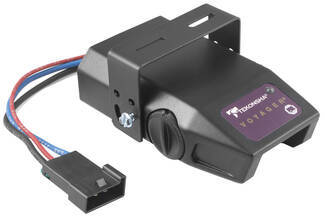
You can fine-tune the gain by adjusting the sensitivity of the internal sensor using the knob on the left side. This controls the aggressiveness of your trailer's braking, meaning how quickly the brakes reach the maximum braking level. You can adjust this when you're towing heavy loads and you need more umph to bring your trailer to a stop. Your tow vehicle doesn't need that much power to brake in time, but your heavy trailer does. A high sensitivity level will get the braking power to your trailer brakes faster and with more intensity so that it doesn't push your tow vehicle forward.
LED Indicator
Keeping with its simple design, the Voyager will not overwhelm you with information. An LED indicator on the top of the unit lights up green to show that your trailer is securely connected to your tow vehicle. The LED indicator will change to red when the brakes on your trailer are activated.
During installation and setup, this light is also used to ensure that the Voyager will be able to function correctly. Proper leveling of the internal sensor is crucial to the operation of this brake controller. When the sensor is level, the LED will change to a shade of orange.
Simple Installation
The Voyager is designed to be mounted in your cab at a vertical angle that is between -20 degrees and 70 degrees. The brake controller needs to be horizontally level and parallel to the direction of travel in order to function properly.


To connect the Voyager, just plug the included harness into your vehicle. The other end plugs into the controller - no hardwiring required.
Once the controller is mounted and connected, you must level the internal sensor. First, set the overall power to the maximum using the knob on the side of the controller. Then, while pressing the tow vehicle's brake pedal, adjust the level knob on the other side of the brake controller (this is the same knob that is used to fine-tune the power output) until the LED monitor is a shade of orange.
Note: If you don't already have a 7-way plug at the back of your vehicle, take a look at our exclusive 7- and 4-way brake controller installation kit (ETBC7 - sold separately).
Proportional Braking
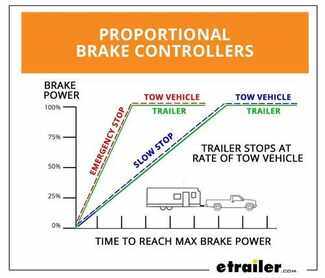
The Tekonsha Voyager brake controller comes equipped with proportional braking to give you the best towing experience. Proportional braking means that your trailer brakes mimic your tow vehicle's brakes. If you slam on the brakes in your vehicle, your trailer brakes will activate with the same intensity; if you brake lightly, your trailer brakes lightly too. The trailer's braking is in proportion to your vehicle's braking. This saves wear and tear on the tires and the brakes on both your vehicle and trailer.
The Voyager uses a pendulum system to sense how your vehicle is braking so it can send the right amount of braking power to your trailer. It measures the inertia of your tow vehicle and activates the trailer's brakes to slow at the same rate. The result is uniform braking across your towing setup. No push-pull action - just smooth, proportional braking every time.
9030 Tekonsha Voyager Electric Brake Controller - 1 to 4 Axles - Proportional
305000 Tekonsha Brake Control Wiring Adapter with 2 Plugs
Replaces 3050-P
Installation DetailsCalifornia residents: click here

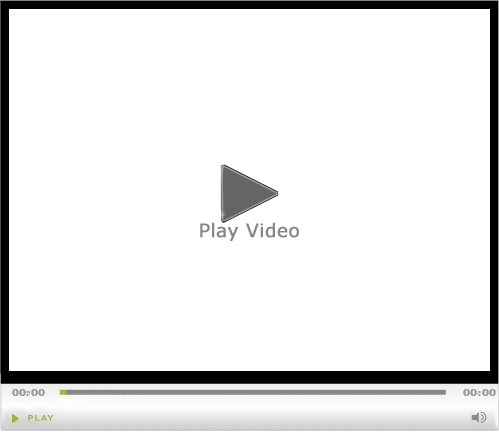
Videos are provided as a guide only. Refer to manufacturer installation instructions and specs for complete information.
Video Transcript for Setting up the Tekonsha Voyager Trailer Brake Controller on your 2011 Nissan Pathfinder
Today on this 2011 Nissan Pathfinder we're going to install part number 39510 from Tekonsha. This is the Voyager trailer brake controller. This vehicle has already been equipped with a 4-pole wiring packaging from the factory. To add our brake controller and connector, we're basically going to just fill in the blanks. We're going to start off underneath the dash. We're going to locate the tow package port underneath the dashboard which is going to be just right of the steering wheel, behind the dash, and also a little bit above the diagnostic port. We'll go ahead and take the adapter cord and plug it into the brake controller, and then we'll go ahead and plug it into the port underneath the dash. The part number for our adapter cord will be3050-P.
With all the brake controller wires plugged together, we'll go ahead and add the bracket to the dashboard underneath. We're going to locate it next to the diagnostic port, just a little bit to the left of it. We'll use two screws to attach the bracket to the dashboard. Next we'll pre-drill the holes in our brake controller to accept the hardware; we'll install the brake controller to your bracket using four more screws; and then we'll go ahead and take a moment to zip tie our wires and make sure they're safe and out of the way. Then we can go to the back of the vehicle. That's where we're going to go ahead and add our 7-pole connector to the back of the vehicle.
That's going to be part number 37185. We're going to take the bracket and hold it to the bottom of the hitch. There's an existing weld nut we're going to use to fasten it to the hitch. We'll hold it up there, make a mark on the bracket, and then we'll go ahead and drill it out to a 3/8 hole. We'll take our bracket back to the vehicle and attach it to the hitch, using an 8 mm bolt, the 1.25 thread hitch; then we'll go and add our 7-pole connector. On the 4-pole end of it we're going to apply some dielectric grease and then attach it to the factory 4-pole.
We're going to run a zip tie through the wires to make it a semi-permanent connection. We'll take a moment to tape up our wires and also add our loom material to help protect some of the wires and make it look nice. At this point we'll go ahead and connect the 7-pole to the bracket, and then we're going to add a length of wire to it about 3 or 4, part number 10-2-1. We'll cut the sheath back and we'll have a black and a white wire. We'll run our black wire to the black wire on the 7-pole connector and our white wire to the blue wire on 7-pole connector. We'll crimp those down and then use some tape to help protect them.There are two remaining wires left.
There'll be a white wire for the ring terminal and a purple wire for the butt connector. We're going to tape those two wires to our grey cable, and we'll run those wires along with the grey cable. Now we're going to route our cables over to the end of the tow package which is located next to the spare tire. We'll measure a length of a grey duplex cable we need and cut the excess off; then we'll strip back to the sheath of the grey cable, exposing the wires we'll need later. Then we can take the white wire with your ring terminal and ground it to the frame. The self-tapping screw we'll be using will be part number SA1131822. We're going to look for a connector that's at the end of our tow package. We've got a small connector with two wires going to it. There will be a brown wire and a purple wire going to it. Now,we don't have a connector to match that, so we'll rotate the connector and remove it from the wires; then we'll go ahead and crimp our wires from our grey cable to those two wires. We'll use a butt connector to make those connections. Our part number for our butt connectors we'll be using will be part number 05732-2. We're going to connect this as follows. Our white wire which will be our brake controller output is going to connect up to the brown wire; and then our other wire, a black wire, will connect up to the purple wire. That'll be our 12 volt power supply. We'll go ahead and tape up our connections and zip tie our wires safe and out of the way. All our connections are done at the back of the vehicle; now we'll go underneath the hood and we have to add one relay to power our 12 volt power supply. There's a relay box closest to the battery. We'll remove the lid and you'll see that there's two relays already installed, and there'll be an open socket for an additional relay. We'll install the relay for our 12 volt power supply, and that's going to included in the kit part #C57000. With all of our connections made, we'll go ahead and test out the brake controller. We'll plug a trailer into it and you'll see that the LED on top will turn from off to a green color; and then we'll use the manual override. You'll see that goes from a green, to a yellow, to a red that shows the manual output works. Now we'll go ahead and try the foot brake. We have to make the level in the brake controller a little bit more aggressive, so we can see it work. Push down the brake pedal and you can see that turns from a green to an orange. And with that, that'll finish it for our install of our Voyager brake controller on our 2011 Nissan Pathfinder.
Customer Satisfaction Score:
97% were satisfied with this product
3% of customers were not satisfied
- Package not accepted
Ratings & Reviews
4.8
750 reviews
See what our Experts say about this Tekonsha Trailer Brake Controller
- Most Economical Trailer Hitch Receiver and Wiring Harness For a 2023 Honda Pilot TouringOur etrailer Trailer Hitch Receiver # e27KR you found is our most economical custom fit receiver for your 2023 Honda Pilot Touring edition. For the wiring you can select from either the 4-Way # C48ZV or the 7-Way # C35ZV depending on the types of trailers you will be towing. If you have a trailer with a 7-way you are also most likely going to need a Trailer Brake Controller # 39510 along with the Wiring # 20127 to connect it. This is one of our most economical and reliable proportional...
view full answer... - Should Blue Wire From Brake Controller Have Constant PowerThe blue wire coming from the back of your Tekonsha Voyager Brake Controller # 39510 is for brake output to the 7-Way connector. This wire should only have power with the brake pedal depressed or the manual override activated on the brake controller. If you are getting constant power on this blue wire this may be an indication that the controller is bad but there is an easy way to test this. You will want to first sever the blue wire several inches from the back of the controller. Then...
view full answer... - Is Reese Voyager and Tekonsha Voyager the Same Brake ControllerThey are the same controller as Reese and Tekonsha are made by the same company. The Tekonsha part # 39510 does not come with the vehicle specific install harness part # 3035-P which is custom fit for your 2003 Ford F-250/350.
view full answer... - Tekonsha Voyager Brake Controller Not Activating Trailer Brakes When Brake Pedal Is PressedYes, we can help you test your brake controller and determine if the controller is bad or if there is a wiring issue that is causing the problem on your 2003 Ford F-250 pickup. Lets start with the easiest things first. Be sure that when you are testing the trailer brakes with the brake pedal that the vehicle is moving. The trailer brakes will not apply with the brake pedal if the vehicle is not moving because of the proportional sensor. The first thing I would check is the red wire that...
view full answer... - Troubleshooting No Green Light on Tekonsha Voyager Brake ControllerThe green light on top of your Tekonsha Voyager Trailer Brake Controller # 39510 indicates that a trailer is connected to your vehicle. If this light is not turning on when connected to a trailer there are a couple things, you can check. I first recommend inspecting both the vehicle side and trailer side connectors for any debris or corrosion built-up around the pins that needs to be cleaned out. If the connectors look good, you will next want to test the brake output pin on the vehicle...
view full answer... - Trailer Brakes Do Not Activate With Brake Pedal When Trailer is Sitting StillActually that is a possibility. Proportional brake controllers will not engage the brakes with the pedal unless the tow vehicle is in motion. Another possibility is the red wire from the brake controller isn't connected correctly. It needs to be connected to the cold side of the stop light switch or the wire that is hot only when the brake pedal is pressed. I would also check any fuses related to towing and replace if necessary. If none of these ideas solves your problem let me know...
view full answer... - Which Harness to Install Tekonsha Voyager in 2019 Ram 1500 ClassicWhat brand and model is the brake controller? The Rams changed quite a bit in 2015 so a new harness would be needed. But if you can get me the controller you have I can help pick you out what you'd need.
view full answer... - Fuse Location to Power an Electric Trailer Brake Controller on a 2005 Chevy SilveradoThe Tekonsha Voyager Brake Controller with GM Wiring Harness, # 39510 and # 3015-P, itself does not have a fuse. Since it is connected to the truck via the factory port under the dash, the fuse for the brake controller 12 volt power is located in the power distribution box under the hood. We actually have an FAQ article that explains the installation of a brake controller Chevy and GMC trucks that includes your 2005 Silverado. It covers the connections that need to be made under the hood...
view full answer... - Voyager Brake Controller Red Light Not Coming On with Brakes Applied on a 2004 Chevy SilveradoThere are several possible causes that would lead the red light not to come on when applying the brakes or manual override on the Tekonsha Voyager Brake Controller, # 39510. First, if truck is not moving, the brakes will not activate. You will also want to check to make sure the power setting is not too low. There may be no signal from the brake light switch. You will need to test the red wire from the back of the brake controller using a circuit tester like # PTW2993. If there is no voltage,...
view full answer... - Troubleshooting a Tekonsha Voyager Brake ControllerHey Scott! You're going to need to connect a trailer to your vehicle. You're not going to know what's working correctly or incorrectly on the Tekonsha Voyager item # TK29ER unless you hook a trailer up. If you run into any problems down the road feel free to comment below or email me directly and I'll be happy to walk through them with you.
view full answer... - Recommended Wiring for 1998 Ford F-150 to Add 7-Way to Factory 4-Way Trailer ConnectionFor your 1998 Ford F-150 Extended Cab with factory 4-way flat, you need the Tekonsha Ford Replacement OEM Tow Package Wiring Harness, 7-Way # 118242. This will give you the two additional relays needed as well as the wiring harness. Then you will need a brake controller. I recommend the Tekonsha Prodigy P3 # 90195 as well as the wiring adapter # 3035-P. This will give you an easy to use proportional brake controller with easy to use presets as well as a nice LCD screen for diagnostics....
view full answer... - What Are the Brake Controller Wire Colors for on a 1998 Dodge Ram 2500The factory electric trailer brake controller wires on a 1998 Dodge Ram 2500 are as follows: Power - Red/Orange Ground - Black/Orange Stop Light - White/Tan Brake Output - Light Blue For a brake controller, I recommend using the Tekonsha Voyager Trailer Brake Controller part # 39510. It sounds like the previous owner of your truck may have cut off the old brake controller port so you are also going to want to use the Replacement Brake Control Plug-In Harness for Tekonsha and Draw-Tite...
view full answer... - Troubleshooting Vehicle that Won't Start After Brake Controller InstallWithout knowing what truck you have it's hard for me to know if you have the correct harness. I will say that the problems you are describing are unlike any problems we have ever seen from installing a brake controller. If removing the brake controller makes the problems go away then I would strongly recommend you do so until you figure out why this problem is occurring. Make sure you have your truck shifted into park or neutral before you attempt to start it. You may have moved the shifter...
view full answer... - Where is the Brake Controller Plug In Located on a 2011 Ford F-250 Super DutyOn the 2011 Ford F-250 Super Duty, the brake controller port is located behind the center dashboard access panel on the passenger's side. One end of the # 3034-P adapter will plug into the back of the brake controller and the other end plugs into the brake controller port on your vehicle. If your vehicle has the factory 7-Way connector on the rear of your vehicle, then all of the wires for the brake controller have already been run. If you have a factory 4-Way connector on your vehicle...
view full answer... - Troubleshooting Voyager Trailer Brake Controller Not Working when Brake Pedal is PressedIt is possible that either the connection to the brake switch is no longer good enough to provide an adequate signal to the brake controller and a new connection will need to be made, or there is a short or possibly a bad ground causing the problem. You may want to also check the stoplight fuse. A blown fuse will not allow the signal to get through and the brake controller will not know you are stepping on the brakes. You can find the fuse by checking your owners manual which should have...
view full answer... - Troubleshooting LED Indicator Light on Tekonsha Voyager Brake Controller 39510The green light on the Voyager brake controller # 39510 should come on as soon as you plug the trailer into the vehicle. If it does not come on at all, this indicates that you either have some corrosion inside the trailer or vehicle plugs that is causing a short, or you have a loose power or ground connection. Check the plugs on both sides of the setup for any white or green corrosion. If you see any, clean the plug thoroughly or just replace it. If you don't see any buildup in either...
view full answer... - Recommended Brake Controller for a 2018 Thor Ace MotorhomeFor your 2018 Thor Ace Motorhome, I recommend using the Curt Spectrum Trailer Brake Controller part # C51170. The reason for this is because this unit is composed of two main parts, the control box and the output knob. The control box gets mounted out of site and then the output knob will get installed up on your dash for easy use and a very aesthetically pleasing look. The color output of the knob also helps with ease of use. Since your motorhome is on a Ford F-53 chassis, you can use...
view full answer... - How to Find the Brake Wire on a 2001 Toyota Tacoma for Brake Controller InstallWhen we installed a brake controller in a very similar Toyota Tacoma as your (see attached install video), we found that the correct wire to use for the stoplight switch was dark green wire with a white stripe. You should still test this wire for voltage with the circuit tester to verify it is the correct one. But this would be an excellent starting point.
view full answer... - Casita Travel Trailer With Repeated Issues On Left Side Of Axle OnlyHello Paul. It sounds like you have an axle, or axle mounts that are out of alignment. That is really the only explanation since the issue has been reoccurring even after several replacements. I wonder if the 1st axle sustained damage of some sort which bent the mounts. This would explain the bearings overheating also. At this point I suggest you take your camper to a shop and have them check the alignment of the axles and the mounts.
view full answer... - Troubleshooting A Tekonsha Voyager Brake Controller That Isn't Sensing The TrailerHi Howard, Typically if the Tekonsha Voyager Trailer Brake Controller # 39510 isn't detecting the trailer it's just an issue with the trailer connectors not making a solid connection. Check the pins on your trailer connector to see if they're corroded, damaged, bent, or dirty. A lot of the time the pins get bent back from connecting to the 7-way socket on the vehicle over and over and just need to be bent back into place with a thin flathead screwdriver so that they contact the pins in...
view full answer... - What To Do if an RV Dealership Installs a Brake Controller Incorrectly and Damages Cruise ControlIt sounds like the RV dealership that installed your Tekonsha Voyager Brake Controller part # 39510 did not install the controller correctly initially, and even though he attempted to rewire the controller the damage was done to your vehicle and now you have lost cruise control. I would recommend having the mechanic look at the circuits like you are doing, and then once they confirm that the initial install of the controller screwed up your cruise control circuit I would go back to the...
view full answer... - Correct Brake Controller Adapter for 2011 Ford F-150If you have one of the following brake controllers, we offer a complete plug-in application. No wiring needed, just plug one end of the Tow Ready Plug-In Wiring Adapter, # 22292, into your brake controller and the other end will plug into the built-in harness beneath the dash on your 2011 Ford F-150. Brake EVN # TK63VR Tekonsha PowerTrac # 39523 Tekonsha P2 # 90885 Tekonsha P3 # 90195 Tekonsha Primus IQ # TK90160 Tekonsha Voyager # 39510 If you have a different brand of brake controller,...
view full answer... - Stop Light Switch Wire for Installing a Brake Controller on a 2013 Audi Q5According to my research the wire that carries the cold side of the stop light switch on your 2013 Audi Q5 should either be Red, Red/Gray, or Red/Black. You will need to test this with a circuit tester like part # PTW2992 and then connect the red wire from the pigtail # 20127 for the Voyager # 39510.
view full answer... - Trailer Brake Controller No Longer Works with Brake Pedal on a 2008 Chevy SilveradoThis sounds like a problem on the red wire. The red wire is the input wire from the brake switch that tells the controller when you are stepping on the brake pedal. Use a circuit tester like # PTW2993 if needed to test the wire. If there is no signal when you step on the pedal, then you know this is the culprit. There are a couple of things you can check but since it was working before the most likely problem is a blown stop light or CHMSL fuse. Use the vehicle owner's manual to find...
view full answer... - Troubleshooting Brakes Staying on When Connected to 7-Way on 2012 Nissan PathfinderThank you for all of the details. I'm glad to hear that all of your lighting functions are working properly. That takes quite a bit of troubleshooting out of the equation. The red wire that was referenced looks to carry the reverse light function. If your trailer has reverse lights then you definitely want to make that connection. For the answer page you are referencing the customer was looking to use the Adapter # 37185 along with the T-One # 118266 which is the equivalent of the Curt...
view full answer... - Towing Setup with Brake Controller, Mirrors and Weight Distribution for 2015 Nissan Frontier Hey Brad! Appreciate you reaching out. Looks like you’ve got an awesome setup with the Frontier and that trailer low miles too, that’s sweet! I’d recommend the Redarc Tow-Pro Elite part # RED44FR for your brake controller — it’s super clean because it's just a little knob on your dash and works awesome for normal towing or even rougher roads. You’ll also need the plug-in adapter part # 3050-P to make it plug straight into your truck’s tow package without splicing anything. For weight...
view full answer... - Brake Controller and 7-Way Recommendation for 2009 Nissan PathfinderTo install a 7-way on your 2009 Nissan Pathfinder you'd need to start with the part # 118281 which is a confirmed fit. Then to install a brake controller you'd be able to use a plug and play style adapter like the # 3050-P and you'd be set. For a brake controller I would recommend the Prodigy P3 Brake Controller part # 90195. This is our best selling brake controller because of how well it works and how easy it is to setup. This is a proportional brake controller that senses the amount...
view full answer... - Factory Brake Controller Port Location on 2017 Nissan TitanTo install the Draw-Tite Activator Trailer Brake Controller # 5504 that you referenced to your 2017 Nissan Titan, all you will need is the Plug-In Wiring Adapter # 3050-P if the truck is equipped with the factory 7-Way. One end of the harness will plug into the brake controller itself, while the other end will connect directly to the factory port on your Nissan Titan. The factory brake controller port should be located behind the dash, on the left hand side by the emergency brake pedal....
view full answer... - Is Aftermarket Trailer Hitch Safe to Use Over OEM Trailer Hitch for a 2017 Nissan PathfinderYes, even though the Draw-Tite Max-Frame Trailer Hitch Receiver # 76031 only uses 6 bolts as opposed to the 10 bolts for the OEM trailer hitch it has gone through an extensive amount of stress tests to ensure that the 6,000 lb trailer towing rating is completely safe. I highly recommend going with this over the OEM for your 2017 Nissan Pathfinder so that you can add some extra components. For a cost-effective brake controller that is reliable I recommend the Tekonsha Primus IQ # TK90160....
view full answer... - Replacement 7-Way Connector Needed for 2007 Nissan FrontierIf you need to change out the complete wiring harness on your 2007 Nissan Frontier then you will need the Replacement Wiring Harness # 118267. If you have the US carr connector still intact then you can use the Pollak # PK11893, but if you just have bare wires you would want the Pollak # PK12-707E instead. I have attached a picture with the typical wiring setup for a vehicle side 7-Way. You will want to use a Circuit Tester # PTW2992 to verify the different functions of your wiring if...
view full answer... - 2006 Nissan Armada Requiring Additional Relay For Trailer WiringSome models require a fourth relay, one of the blue relays from the Curt Relay Kit # 57000. It is installed under the dash on the left side of the steering column. There is a socket there to plug in the relay that will activate the tow package tail lights on the Armada, if it was not installed at the factory. Since you already installed the Relay Kit, part # C57000, adding this 4th relay should take care of the problem with the running lights.
view full answer... - Weight Distribution and Brake Controller Recommendation for a 2011 Nissan FrontierFor a weight distribution system that offers sway control and the ability to backup without removing the spring bars or sway control, I recommend looking at our Blue Ox SwayPro systems. I have attached a link to all of the SwayPro systems for you to check out. In order to choose the best weight distribution for your truck and trailer, you will want to determine the total tongue weight of your towing setup. The total tongue weight will include the loaded and ready to tow tongue weight...
view full answer... - Testing Prodigy P3 Brake Controller Power Output on 2011 Nissan PathfinderThe Tekonsha Prodigy P3 # 90195 is a great fit for your 2011 Nissan Pathfinder using the wiring harness # 3050-P. There is no additional relay or anything required. Since you know there is power getting to the controller the best way to test if power going out from the controller is to test the blue brake controller output wire. You can do this behind the harness or you can do this at the 5 o'clock pin of your 7-way trailer connector using a circuit tester like # PTW2993. Because...
view full answer... - Recommended Brake Controller for 2018 Nissan Titan With Factory 7-WayFor your 2018 Nissan Titan I very strongly recommend going with the Redarc Tow-Pro Elite item # RED44FR over the Curt Spectrum item # C51170, which does use Wiring Adapter item # C51382 to connect to your 2018 Nissan Titan. The Redarc Tow-Pro item # RED44FR, which you can install in your '18 Titan with Wiring Adapter item # 3050-S, is by far the superior option because it is not only extremely effective and responsive but its manual control knob makes it simple to use; the Tow-Pro can...
view full answer... - Where to Connect the Adapter to Install a Curt Brake Controller in a 2017 Nissan PathfinderTo install a Curt Brake Controller, like the Discovery # C84VV, on your 2017 Nissan Pathfinder you will simply need to plug the Custom Wiring Adapter # C51382 under your dash like you mentioned. I am attaching a video where one of our install guys installed a Tekonsha Prodigy P2 # 90885 in a 2013 Pathfinder using the Tekonsha Wiring Adapter # 3050-P. If you skip to the 2:45 mark you can see where he plugs in the adapter for the Prodigy P2. Your Curt adapter will plug into the same place.
view full answer... - Trailer Hitch Receiver and Wiring Harness for a 2017 Nissan Titan with No Tow PackageEven though your 2017 Nissan Titan doesn't have the tow package it should still have the standard round connector to install trailer wiring behind the rear bumper. Part # N40975 includes the 7-way and 4-way connector that plugs right into your truck, as well as the relays to installto activate the wiring. I've linked a video that shows the install on a 2010 Titan for you. The process is the same. With a trailer that large it's likely to hve brakes so you need a brake controller. I...
view full answer... - Can Tekonsha Brake Controller Install in 2020 Nissan PathfinderHey Bett, yes you can use your Tekonsha Pilot in your 2020 Nissan Pathfinder and you'll just need to use the install harness part # 3050-P.
view full answer... - How Long is the Electric Brake Controller Pigtail Adapter For Tekonsha Brake ControllersI went out to the warehouse and pulled the Tekonsha Plug-In Wiring Adapter for Electric Brake Controllers, # 3050-P and found that it is 31-3/4 inches long overall, including the connectors. I produced a short video showing the length of the adapter for you. The # 3050-P harness is compatible with the Prodigy 2, # and all of the Tekonsha brake controllers in current production. At this time the manufacturer lists this harness for the 2004 - 2012 Nissan, Armada, All Styles. This could...
view full answer... - Recommended Trailer Hitch Receiver, Wiring, and Weight Distribution for 2013 Nissan Armada 4x4For your 2013 Nissan Armada, I recommend the Curt Trailer Hitch Receiver # 13188. This will be able to tow your trailer with 1 horse without weight distribution, but you will most likely need the weight distribution system for 2 or 3 horses. It will also help with sway control, so I would use it no matter the number of horses. For your wiring, if you don't have the factory 7 way, I recommend the Vehicle Wiring Harness Kit with 4 Pole Trailer Connector # C59236 along with the # ETBC7...
view full answer... - Availability of Wiring Harness for 2024 Nissan Pathfinder Rock Creek Using Redarc Tow-Pro LibertyHey Charles! Redarc doesn't have a specific wiring harness but you can still make the Redarc Tow-Pro Liberty # RED52VR you ordered plug and play. I see you ordered the Tekonsha # 3050-P as well. This will plug into the factory port under your dash but it won't fit into the Liberty. You will also need the Redarc Tow-Pro Wiring Adapter for Tekonsha Brake Controller Harness # 331-TPH-017 to make the two compatible. What kind of trailer will you be towing?
view full answer... - Looking For Brake Controller For 2024 Tesla Model YHello Randolph, thanks for reaching out. We do have brake controller options for the 2024 Tesla Model Y. Does your Tesla already have a 7-way trailer plug? If not, you will first need to install the ZCI Circuit Protected Vehicle Wiring Harness # 119250KIT along with the Universal Installation Kit # ETBC7. This will give you a 4-flat, 7-way and all the necessary wires for a brake controller. For that, I recommend the following: - Redarc Tow-Pro Liberty Brake Controller w/ Universal Wiring...
view full answer... - Should I Get a Proportional or Time-Delayed Brake ControllerThe best brake controller option to go with is one that activates the brakes proportionally instead of time delayed. A proportional brake controller will activate the trailer brakes at the same time and with the same intensity as the tow vehicle brakes whereas a time delayed brake controller will activate the brakes at a predetermined time and intensity once the brake pedal is pressed in the tow vehicle. This can cause uneven wear of the brakes and tires. Proportional brake controllers...
view full answer... - Brake Controller for 2024 Nissan Pathfinder Towing Trailer with Electric Over Hydraulic BrakesHey Jeffrey, so we have just what you are looking for with the Prodigy P3 part # 90195. This controller has an EOH setting to allow it to be used with the type of brakes your trailer will have and is widely considered to be the best controller on the market. To install it all you need is the install harness # 3050-P.
view full answer... - Recommended Trailer Harness Wiring For 1996 Ford F-250 To Tow Fifth Wheel TrailerThere are a few scenarios here. If you have a factory-installed 4-way connector then that makes a difference down the road when installing a brake controller. There may be a brake controller port under the dash on your F-250 and an adapter can be used with a brake controller. The first thing you want to do is find out if your 4-way connector is operational. If it is working, that may save you some money. You can use a circuit tester like part # PTW2993 for that. Have someone sit in the...
view full answer... - Location of Brake Controller Adapter Port to Install Prodigy P3 on 2019 Nissan PathfinderTo install the Prodigy P3 Trailer Brake Controller # 90195 in your 2019 Nissan Pathfinder you can find the brake controller port directly under the dash as in the accompanying photo. This will allow you to plug in the Tekonsha Plug-In Wiring Adapter for Electric Brake Controllers # 3050-P. I recommend going to the linked video showing this brake controller being installed on a Pathfinder; if you go to the 6:30 mark you can see the exact location.
view full answer... - Plug-And-Play Electric Trailer Brake Adapter Harness For A 2022 Nissan Frontier Tekonsha has not released any information on when that might be available, but I do have a solution. For your 2022 Nissan Frontier, you can use the Redarc Tow-Pro Elite Trailer Brake Controller # RED44FR, with the plug in adapter # RED39FR. This is a plug-and-play harness, that will plug underneath the dash on your 2022 Frontier like you had mentioned. If you don't already have a 7 way located at the rear of your vehicle, # ETBC7 is a simple to install kit that will work great with your...
view full answer... - Brake Controller Install and Recommendation for a 2007 Nissan FrontierWe had a customer with a 2007 Nissan Frontier just like yours have trouble finding the port to install the brake controller harness needed to plug in the # 3050-P come back and say he was able to find it above the gas pedal. I attached the picture he sent us that shows where it was. For a brake controller I would recommend the Prodigy P2 Brake Controller part # 90885. This is our best selling brake controller because of how well it works and how easy it is to setup.
view full answer... - Recommended Brake Controller For 2019 Nissan Armada With Factory Tow PackageWe can get your 2019 Nissan Armada with the factory tow package set up with a trailer brake controller, and since you have the tow package all you'll need is the brake controller and wiring adapter. For your '19 Armada I highly recommend an option from Tekonsha: - Tekonsha BRAKE-EVN Trailer Brake Controller # TK63VR - Tekonsha Plug-In Wiring Adapter # 3050-P I really like the BRAKE-EVN # TK63VR because it is the best overall value for a trailer brake controller; the reason for that is...
view full answer...
Do you have a question about this Trailer Brake Controller?
Info for this part was:





At etrailer.com we provide the best information available about the products we sell. We take the quality of our information seriously so that you can get the right part the first time. Let us know if anything is missing or if you have any questions.




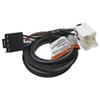































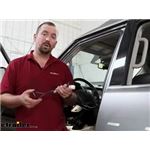
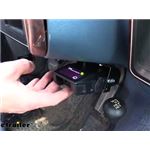
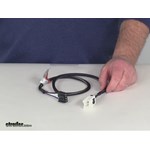
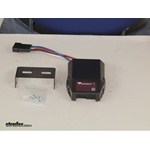



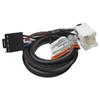





















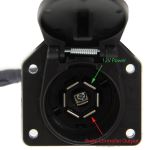




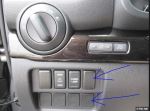

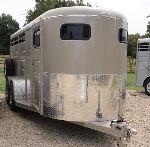
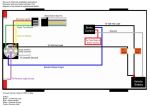

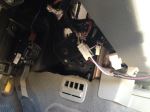
Thank you! Your comment has been submitted successfully. You should be able to view your question/comment here within a few days.
Error submitting comment. Please try again momentarily.